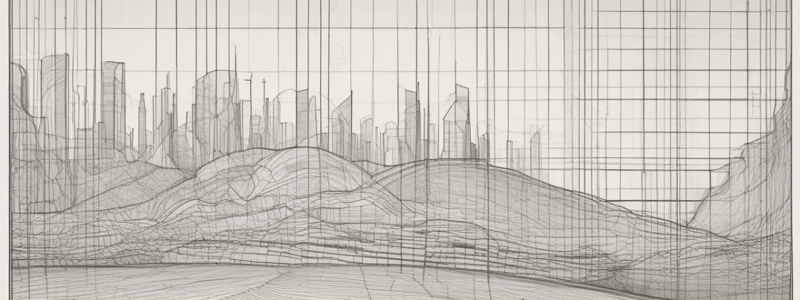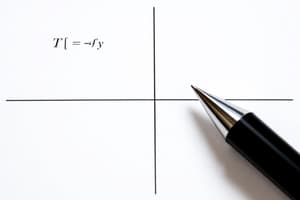Podcast
Questions and Answers
What does an indifference curve represent?
What does an indifference curve represent?
- The combination of two goods that provides the highest level of satisfaction
- The change in the relative values of two goods
- The rate at which a consumer is willing to give up one good for another
- The various combinations of two goods that a consumer is indifferent to (correct)
What is the shape of an indifference curve?
What is the shape of an indifference curve?
- Downward sloping and convex (correct)
- Downward sloping and concave
- Upward sloping
- Horizontal
What happens to the quantity of one good when the quantity of the other good increases, assuming a constant level of satisfaction?
What happens to the quantity of one good when the quantity of the other good increases, assuming a constant level of satisfaction?
- It remains constant
- It increases
- It becomes zero
- It decreases (correct)
What is the marginal rate of substitution?
What is the marginal rate of substitution?
What does the slope of the indifference curve represent?
What does the slope of the indifference curve represent?
What is true about indifference curves?
What is true about indifference curves?
Indifference curves are upward sloping, indicating a direct relationship between the quantities of two goods.
Indifference curves are upward sloping, indicating a direct relationship between the quantities of two goods.
The marginal rate of substitution is the rate at which a consumer is unwilling to give up one good for another.
The marginal rate of substitution is the rate at which a consumer is unwilling to give up one good for another.
Indifference curves intersect, indicating that a consumer can be indifferent to different combinations of goods that provide the same level of satisfaction.
Indifference curves intersect, indicating that a consumer can be indifferent to different combinations of goods that provide the same level of satisfaction.
The marginal rate of substitution remains constant as the consumer moves along the indifference curve.
The marginal rate of substitution remains constant as the consumer moves along the indifference curve.
Indifference curves are concave to the origin.
Indifference curves are concave to the origin.
The slope of the indifference curve represents the total utility or satisfaction derived from consuming two goods.
The slope of the indifference curve represents the total utility or satisfaction derived from consuming two goods.
What does the convex shape of an indifference curve indicate about the marginal rate of substitution?
What does the convex shape of an indifference curve indicate about the marginal rate of substitution?
How does the marginal rate of substitution change as a consumer moves along an indifference curve?
How does the marginal rate of substitution change as a consumer moves along an indifference curve?
Why do indifference curves not intersect?
Why do indifference curves not intersect?
What is the relationship between the quantity of one good and the quantity of the other good on an indifference curve?
What is the relationship between the quantity of one good and the quantity of the other good on an indifference curve?
What does the slope of the indifference curve at a particular point represent?
What does the slope of the indifference curve at a particular point represent?
What does the downward slope of an indifference curve indicate?
What does the downward slope of an indifference curve indicate?
Flashcards are hidden until you start studying
Study Notes
Indifference Curves
- An indifference curve is a graph that shows all the combinations of two goods that give the same total utility or satisfaction to a consumer.
- It is a way to visually represent the various combinations of two goods that a consumer is indifferent to, meaning they provide the same level of satisfaction.
Characteristics of Indifference Curves
- Indifference curves are downward sloping, meaning that as the quantity of one good increases, the quantity of the other good decreases, assuming a constant level of satisfaction.
- Indifference curves are convex to the origin, meaning that they bow inward, indicating that the marginal rate of substitution between the two goods changes as the consumer moves along the curve.
- Indifference curves do not intersect, meaning that a consumer cannot be indifferent to two different combinations of goods that provide the same level of satisfaction.
Marginal Rate of Substitution (MRS)
- The marginal rate of substitution is the rate at which a consumer is willing to give up one good for another while maintaining the same level of satisfaction.
- MRS is the slope of the indifference curve at a particular point, representing how many units of one good a consumer is willing to give up for an incremental unit of another good.
- MRS changes as the consumer moves along the indifference curve, reflecting changes in the relative values of the two goods.
Example of an Indifference Curve
- The graph shows an indifference curve for two goods, chocolate and fruit, with the quantity of chocolate on the vertical axis and the quantity of fruit on the horizontal axis.
- The indifference curve shows that the consumer is indifferent between different combinations of chocolate and fruit that provide the same level of satisfaction.
- The slope of the indifference curve changes as the consumer moves along the curve, reflecting changes in the marginal rate of substitution between the two goods.
Studying That Suits You
Use AI to generate personalized quizzes and flashcards to suit your learning preferences.




